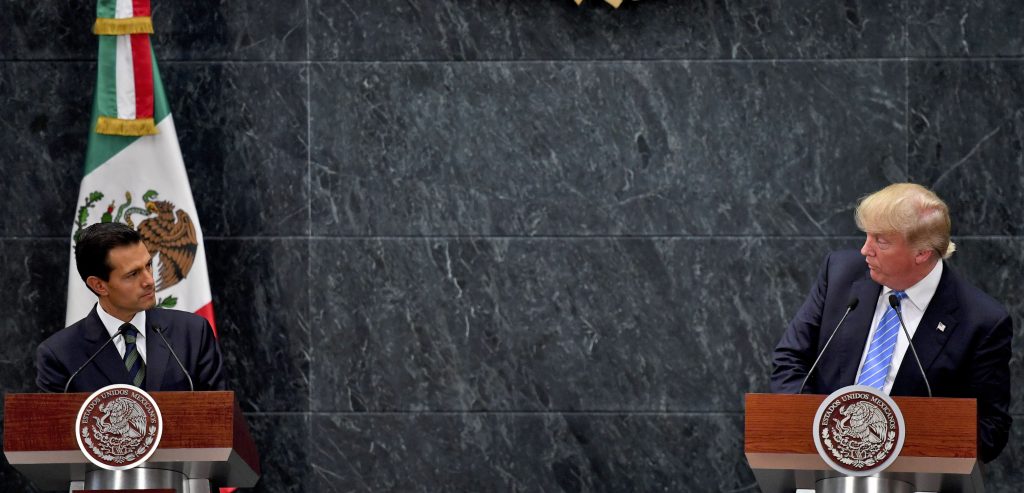By George Friedman
Donald Trump made a move that will either go down as sheer genius or utter idiocy. Trump’s problem is that he is continually behind Hillary Clinton in the polls by about five points. He is also substantially behind her in the electoral college. This has been roughly the situation since the Democratic Convention, although there has been a small move toward Trump in the national polls, but almost none in the electoral college. He has a substantial base of voters, about 40 percent, and he must move about 6 to 7 percent to win the popular vote and eke out the electoral.
That should not be impossible. But Trump has little room to grow. The number who say they have negative views of him are most of the rest of the electorate. Clinton is also disliked intensely, but her negative numbers, while substantial, are less than his. If this were election day, he would lose. He has to find a strategy that would allow him to roll back his negatives somewhat and win over a few of those who are voting for Clinton only because she isn’t Trump.
His problem is that what he did in order to win the Republican nomination was what created these negative feelings. To make inroads there, he had to do two things. First, he had to alleviate the sentiment that he was unable to serve as president because of profound character flaws. Second, he opened his campaign by attacking Mexican illegal immigrants and Muslims, as well as free trade and the U.S. alliance system. He wound up in a position where he either reduced the negatives or gave up the election. Clinton reportedly already started choosing her Cabinet.
Mexican President Enrique Peña Nieto threw Trump a lifeline, which was extraordinary, given the things Trump said about Mexico. Peña Nieto invited Trump and Clinton to meet with him in Mexico. Now, for Clinton this didn’t mean much. She hasn’t got a Mexico problem. For Trump it offered a possibility to go into hostile territory, demonstrating self-control and shifting stance a bit. If he failed, he was in no worse condition than before – losing. If he succeeded in winning over voters he could change the race.
As I said, Clinton didn’t play in this game, so the question is why Peña Nieto offered Trump this chance. Peña Nieto can’t run again, his own favorability ratings are in the 20 percent range, and he knew inviting Trump would create a collective rage attack in Mexico. Given that his own numbers can only rise, and he is barred from running for re-election, the answer might actually be statesmanship. If Clinton wins, Mexico’s relations with the United States stay the same. If Trump wins, relations can turn disastrous. Mexico needs the U.S. far more than the U.S. needs Mexico. By reaching out to Trump, he might be able to soften Trump’s positions and create a personal relationship, based on the assumption that Trump isn’t actually committed to the things he says. This would infuriate Clinton, but Peña Nieto calculated that it didn’t matter, as she was locked into her position on Mexico.
Trump jumped at the chance. First, he got to stand side by side with the president of Mexico and show that he could speak coherently. This was a double win. Second, it gave him a chance to refine – or moderate, depending on your point of view – his position.

The most important thing he did was to say that he wants to renegotiate NAFTA based on current conditions, which is the position the Mexican government adopted recently. He also tied the U.S. immigration problem to the Mexican immigration problem. The Mexicans have a serious problem with illegal immigrants from Central America. Trump said that the problem of illegal immigrants is a Mexican as well as an American problem. He took the opportunity to praise the contribution of legal Mexican immigrants in the United States. Trump also linked stopping the flow of drugs to the United States with stopping the flow of guns from the United States to Mexico. Private ownership of weapons is tightly controlled in Mexico, and Mexico has charged that its violence is due to the flow of illegal arms there.
Trump also started raising a new claim: countries in the Western Hemisphere need to face China together, because China’s unfair competition is hurting all countries in the hemisphere equally. He stuck to his plan to build the wall between the U.S. and Mexico, but put off the question of who would pay for it.
It was a clever speech. He didn’t abandon any positions, but reshaped them. He said little that would cost him any of his base, but which conceivably could change the small percentage of minds he needs to get into the race. For those who felt that Trump was out of control emotionally, he showed he could be controlled for this meeting. For those who felt he had no grasp of issues, he made (or read) a coherent speech. He actually demonstrated some subtlety. Most people with negative opinions of him could not be swayed regardless of what he said or did. But the people he was after were those who hated Hillary and were planning to vote for her only because Trump was unacceptable. For those looking for an excuse not to vote for Clinton, he did the best he could.
We won’t know if he swayed them for a while, until the polls metabolize this meeting and his speech on immigration. They may not move, since most people are locked into their position. But it is a beautiful example of a zero-risk, high-reward maneuver. The question still is why Peña Nieto gave it to him, and I think my analysis is likely the right one. Indeed, I would guess that the advisers for Trump and Nieto choreographed this, including leaving Clinton on the sidelines. But if Trump ever had a chance to pull even, this was his chance. It may be too little, too late, but he didn’t fumble it.








